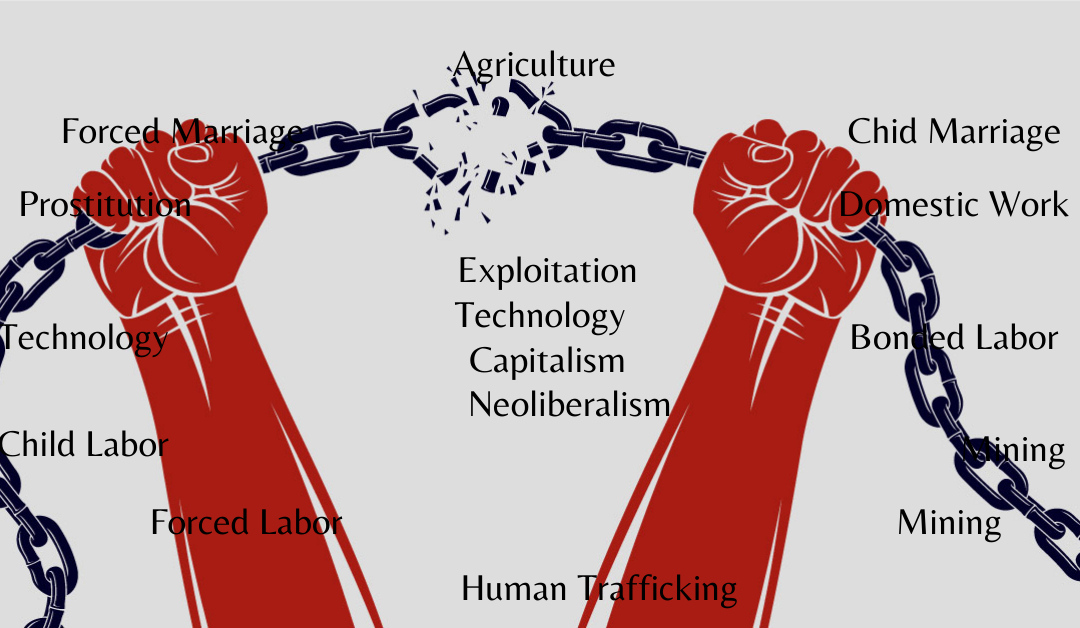Those who are not familiar with conversations within the labor market, human rights, and migration studies might perhaps not be familiar with the term “modern slavery.”
Modern slavery employs force and exploitation as a means of getting people to work or perform other actions. Badmus, Oladiran, and Badmus provide an extensive definition; to them it is the “recruitment, transportation, transfer, harboring or reception of persons, including the exchange or transfer of control over those persons, by means of threat or use of force or other forms of coercion, of abduction, of fraud, of deception, of the abuse of power or a position of vulnerability or the giving or receiving of payments or benefits to achieve the consent of a person having control over another person, for the purpose of exploitation” (2020, p. 23). This explanation indicates that modern slavery is influenced by the ability of a superior to control and oppress a subordinate. In this case, there is the power tussle. By implication, the opposite words such as rich and poor, old and young, superior and subordinate, tall and short, oppressor and oppressed, literate and illiterate, among others are some of the lexicons that become the modus operandi in societies where modern slavery is inherent. Moreover, modern slavery tradition can be traced back to the transatlantic slave trade that began in the 16th century and ended in the 19th century.
Economic Imbalance and Technological Advancement
With the advancement in technology and economic imbalance in developing nations, modern slavery continues to be the practice. Many individuals in search of means of livelihood subject themselves to this inhumane practice. Examples of modern slavery include forced labor, child labor, human trafficking, child marriage and forced marriage, prostitution (sex workers in foreign lands), bonded labor, forced construction and agricultural labor, domestic work, forced sexual exploitation, and the not so considered casual and contract employment. According to the International Labor Organization, the estimated number of people in forced labor or human trafficking as of 2016 is 40 million: 25 million in forced labor and 15 million in forced marriages.
Modern slavery mostly impacts women and children. The Global Slavery Index (GSI) accounts that women and girls make up 71%, while children make up 25% of the victims of modern slavery. Invariably, children make up 10 million persons of the number of slaves globally. For instance, in the Democratic Republic of Congo (DRC), young children from as young as 6 years old work with a shovel or bare hands at cobalt mines to dig out coltan and other precious stones used for mobile phones, electric cars, and aircrafts production. Also, women and children are most times victims of sexual exploitations as sex workers, bonded laborers as in the case of sex workers who work to pay their mistresses or masters the debt owed on transportation costs to the foreign country where they work, forced marriage as in the case of young girls who marry before the age of 18, and servants who work as domestic workers in households in countries such as Dubai, Lebanon, and Oman.
Prevalence Index of Modern Slavery
The 2018 GSI identifies 167 countries where modern slavery is prevalent. However, 10 countries have the highest occurrence of modern slavery. These include North Korea, Eritrea, Burundi, the Central Africa Republic, Afghanistan, Mauritania, South Sudan, Pakistan, Cambodia, and Iran. North Korea ranks highest with a 104.5 score.
These data reveal certain trends. These include 1) the prevalence of modern slavery in conflict high nations such as Eritrea, Burundi, the Central Africa Republic, Afghanistan, South Sudan, and Pakistan; 2) the government’s imposition of modern slavery by practice. For instance, in North Korea 1 in 10 persons are forced to work for the government; 3) the unexpected prevalence of modern slavery in developed nations: this owes to the heavy consumption of resources that are produced through this crime such as clothes, phones, and more by G20 nations. The yearly revenue accrued globally from modern slavery is $150 billion (£116 billion).

Although G20 nations are working effortlessly to eradicate this epidemic. According to the reports from GSI, the 10 countries actively seeking to put an end to the crime include, the United Kingdom, the Netherlands, The United States, Portugal, Sweden, Argentina, Belgium, Spain, Croatia, and Australia. Unfortunately, they are highest consumers of the end products of the crime. This Then begs the question: “how do we really eradicate modern slavery?”
Harms of Modern Slavery
For the 21st-century global economy, the harms of modern slavery are enormous. These include the challenge we have today with human capital development, economic abuse, social exclusion, and human rights deprivations. Also, the harms of modern slavery could make or mar the achievement of the Sustainable Development Goals (SDGs) in 2030 and Universal Human Rights Declarations.
Sources
Ana Lucia Araújo, “Slavery and the Atlantic Slave Trade in Brazil and Cuba from an Afro-Atlantic Perspective,” Scielo, 2016, https://www.scielo.br/scielo.php?script=sci_arttext&pid=S2236-46332016000100001#:~:text=In%201885%2C%20Brazil%20enacted%20the,only%20on%20May%2013%2C%201888.
Antislavery.org, What is modern slavery? Accessed Aug. 23, 2020, https://www.antislavery.org/slavery-today/modern-slavery/
Badmus, Bidemi G, Oladiran, Afolabi, and Badmus, Adedayo T., “Modernisation or Modern Slavery: The Concept of Casual/Contract Labour and the Dilemma of Economic Growth in Nigeria.” ARC Journal of Addiction Volume 4, Issue 2, 2020, PP 17-33, accessed Aug. 23, 2020, https://www.researchgate.net/publication/320101344_Modernisation_or_Modern_Slavery_The_Concept_of_CasualContract_Labour_and_the_Dilemma_of_Economic_Growth_in_Nigeria
Free the Slaves, Slavery Today, https://www.freetheslaves.net/our-model-for-freedom/slavery-today/?gclid=Cj0KCQjwo6D4BRDgARIsAA6uN1_4uPmpUcyK_AneLYftxtD8FaxZYSVLmot8XFi36BQqipacyngi2M4aAu9vEALw_wcB
Global Slavery Index, Executive Summary, 2019, https://www.globalslaveryindex.org/2019/findings/executive-summary/
Global Slavery Index and Walk Free, Global Findings: Global Slavery Index, 2018, https://www.globalslaveryindex.org/2018/findings/global-findings/
Molly Millar, “Five Years On, Is The UK’s Landmark Anti-Slavery Law Fit for Purpose?,” Reuters, 2019, https://www.reuters.com/article/us-britain-slavery-expertviews-trfn/five-years-on-is-the-uks-landmark-anti-slavery-law-fit-for-purpose-idUSKBN1WX02J
Labordoc: ILO Digital Repositories, Global Estimates of Modern Slavery, 2017, p. 5, https://ilo.userservices.exlibrisgroup.com/discovery/delivery/41ILO_INST:41ILO_V2/1248649730002676
Nwachukwu Egbunike, “Arrowing Talks from African Domestic Workers in Lebanon,” Global Voices https://globalvoices.org/2020/06/25/harrowing-tales-from-african-domestic-workers-in-lebanon/
Suyin Haynes, “Slavery Still Exists All Around the World. Here’s How Some Countries Are Trying to Change That,” Times, 2019, https://time.com/5741714/end-modern-slavery-initiatives/
TheCable, PHOTOS: Nigerian Women Stranded in Lebanon Return Home, Accessed August 23, 2020, https://www.thecable.ng/photos-nigerian-girls-stranded-in-lebanon-return-home
Trafficking Matters, “Legislating against Modern Slavery, Human Trafficking, and Forced Labour,” 2013, https://www.traffickingmatters.com/wp-content/uploads/2018/09/e-handbook-modern-slavery_webpdf.pdf



Recent Comments